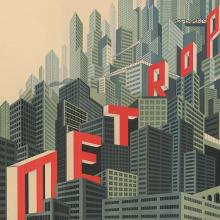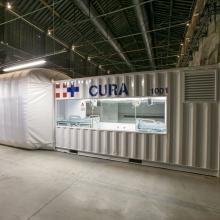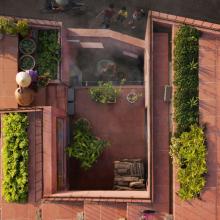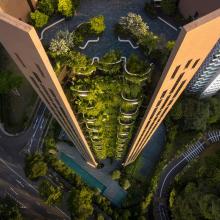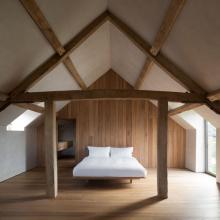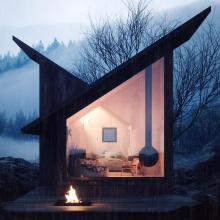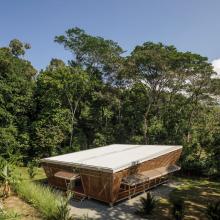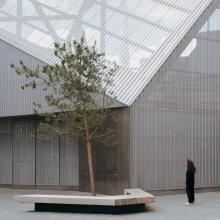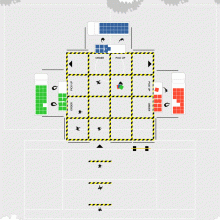Dezeen's top 10 architecture trends of 2020
Continuing our review of 2020, here are 10 of the most interesting architecture trends, from escapist cabins to Thomas Heatherwick's green thumb and, of course, architects' responses to the coronavirus pandemic.

Prefabricated cabins
Factory-made homes are a hot topic in discussions of addressing global housing shortages, but 2020 was the year that architects explored their dreamier qualities. Perhaps it was the seemingly endless isolation, but prefabricated cabins that can be packed off to remote locations for living out an off-grid fantasy were very popular this year.
Muji was first out of the gate with Yō no Ie, a single-story dwelling designed for rural areas that features an expansive deck – complete with a sunken conversation pit – to encourage outdoor living.
Italian architects Massimo Gnocchi and Paolo Danesi provided a romantic vision of modular construction with Mountain Refuge, a concept for a plywood micro home designed for relaxing in the wild.
Studio Puisto also created a modular prefabricated cabin called Space of Mind that can function as an off-grid retreat or, in light of the coronavirus pandemic, as an extra room for working or exercising. The A-frame Den Cabin Kit also arrives in a flatpack kit of parts and can be assembled in just a few days.

Coronavirus field hospitals
As the coronavirus pandemic put hospitals around the world under pressure, architects and builders sprang into action to create field hospitals to treat patients.
In Wuhan, China, where the outbreak began, work continued through the night at the end of January on the 1,000-bed Wuhan Huoshenshan Hospital. In February it was able to accept its first patients after just nine days of construction.
Italy was one of the earliest countries to be hit hard by Covid-19, with hospitals quickly reaching capacity. In March, Italian architects Carlo Ratti and Italo Rota developed an intensive care unit housed in a shipping container and by April the first two-bed unit was accepting coronavirus patients in a Turin hospital.
In the UK, architecture and engineering firm BDP helped turn the ExCel centre, a London conference venue, into the 4,000-bed NHS nightingale.

Aerial photography
As drones become more and more accessible, architecture photographers took to the skies to capture a birds-eye view of structures.
Aerial photographer Tom Hegen produced a series of photos of greenhouses in the Netherlands to ask questions about the world's food supplies.
Photography from above was a particular theme in the projects that won in Dezeen Awards 2020. Shots from the sky showed off the stepped roof garden of a red house in Vietnam by TAA, which won rural house of the year and architecture project of the year.
Aerial photography also captured arresting visuals of the civic building of the year, a primary school in Iran by FEA Studio, and a bicycle park in Copenhagen by COBE that won landscape project of the year. Drone photography also featured in shots of a treetop cycling circuit by BuroLandschap and De Gregorio & Partners, which was crowned infrastructure project of the year.

Biophilic Heatherwick
Heatherwick Studio flew the flag for biophilic architecture in 2020 – the practice of integrating plants to create indoor spaces that still allow occupants to connect to nature.
For its Maggie's Centre in Leeds, UK, the architecture firm created a timber-lined space filled with greenery and shelves especially for plant plots. With its grass-covered roof, the centre is designed to provide respite for people living with cancer.
In Singapore, the Thomas Heatherwick-founded practice completed a 20-storey residential tower apartment building called EDEN that's covered in plants, thanks to each home having its own balcony-style garden.
Even on a much smaller scale, the studio found ways to help people bring greenery into their homes, creating a desk that has plant holders for legs.
Architecture on film
2020 was the year that lots of people finally had time to catch up on their to-watch list.
To ease the boredom of lockdown and the loneliness of self-isolation, Dezeen put together a list of all the most interesting architecture on the big screen, and a round-up of all the top architecture and design documentaries to watch in quarantine.
It was so popular we also put together a spooky list of films and television shows where the haunted house plays a starring role.
Readers were inspired to share their own must-see film favourites, and we published these top quality recommendations in a list of their own.

Carbon-neutral architecture
As the world wakes up to the serious risk of a climate emergency, the architecture industry took a serious look at how the sector needs to cut its contribution. Some studios have become pioneers of carbon-neutral architecture – where a structure doesn't release more carbon dioxide into the atmosphere than it traps in place, or is designed to run on renewable energy sources.
Architecture studio A-01 unveiled a prototype for zero-carbon housing in Costa Rica, and a carbon-neutral hotel designed by Von M opened in Germany.
Stirling Prize-winning studio Mikhail Riches has a plan to deliver 600 Passivhaus homes in York, which is set to be the largest net-zero carbon housing scheme in England. In Wales, Loyn & Co is planning a 35-home net-zero-carbon housing scheme that will be built from cross-laminated timber (CLT).
People also shared tools to help other professionals achieve carbon neutrality. Construction company Skanska and software developer C Change Labs created a calculator to help compare the environmental impact of materials, and Feilden Clegg Bradley Studios made a spreadsheet that can predict a building's carbon emissions over its lifespan.

Self-designed homes
Everyone was in the market for a little home improvement after months of staring at the same four walls, but no-one does a makeover quite like architects designing their own homes.
British architect John Pawson unveiled Home Farm, his minimalist countryside retreat set in a series of converted 17th-century farm buildings. Edinburgh pair Luke and Joanne McClelland carved a lateral apartment out of a set of Georgian townhouses.
In Australia, John Wardle remodelled his house of over two decades, while architect Simon Pole and graphic designer Annabel Dundas created a family home on the banks of the Yarra River.
More architects who became their own clients include the owners of Berman Horn Studio, who built their holiday home in Maine, and Lorenzo Grifantini with his house in Puglia.
Bjarke's BIG year
BIG founder Bjarke Ingels made plenty of headlines in 2020. In January he was heavily criticised for meeting with Brazil's controversial president Jair Bolsonaro. Ingels defended the meeting, arguing that "creating a list of countries or companies that BIG should shy away from working with seems to be an oversimplification of a complex world".
In March, as the pandemic bit, BIG turned its 3D printing facilities in New York over to making face shields. "The massive urgency and shortcomings of the traditional provisions and supply chain during the Covid outbreak has revealed the flexible making capacity that resides in so many places you don't normally associate with manufacturing, like architecture and design studios," Ingels told Dezeen.
In Albania there were protests in May over plans to replace Tirana's national theatre with a BIG design. Ingels made front-page news again in October, where a profile in TIME magazine revealed the extent of his next project: redesigning the entire planet to solve climate change.
His studio also announced some high profile projects in 2020, including a 3d-printed Moonbase for NASA, a city built out of wood at the foot of Mount Fuji, and a Virgin Hyperloop testing facility for Virginia.

Disguised ventilation shafts
Cunningly-disguised infrastructure elements were a more unexpected trend in 2020.
Grimshaw unveiled a range of vents for HS2 that will be masquerading as something else, including a farmyard barn in Chalfont and a sculptural crown-shaped landmark for Amersham.
Neiheiser Argyros built a white metal pavilion that integrates a digital screen, a cafe and public toilets to hide the fire escape and exhaust vents of the London Underground. On another part of the line, Cullinan Studio built an energy centre over the top of a vent to turn hot air created by the Northern Line into hot water for the surrounding homes – all hidden behind a bright red perforated metal screen.

Social distancing
Architects stepped in to help people and businesses cope with the pandemic, redesigning places and spaces so that people could use them while keeping a distance of over a metre from each other.
Dutch studio Shift Architecture Urbanism came up with a model to allow food markets to re-open safely, and Italian practice Caret Studio painted a public square in a town near Florence so that residents could socialise outdoors.
Weston Williamson + Partners put together a plan to help workplaces to comply with social distancing rules, and The Manser Practice did the same for hotels.
MASS Design Group came up with strategies to help bars and restaurants separate customers, while Isometric Studio put together a toolkit for museums and galleries.
Precht presented a design for a socially distanced park based on a hedge maze, and Arup made miniature parks with built-in benches to help businesses re-open in Liverpool.



